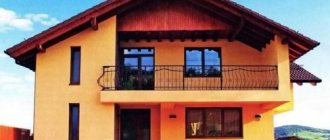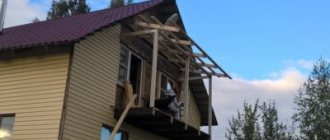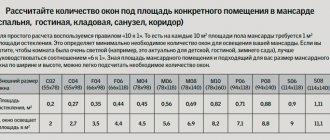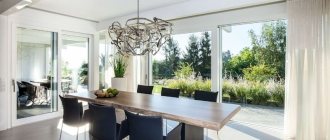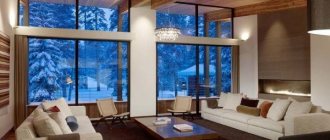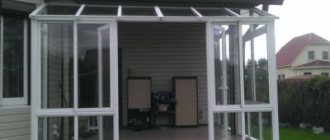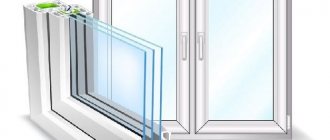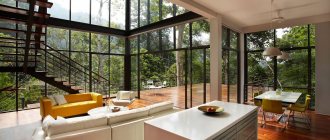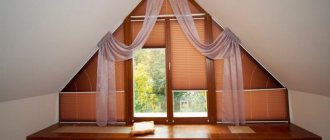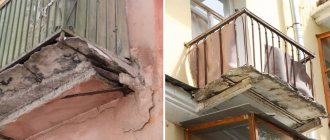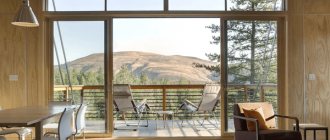In order for the floors on an open balcony to look great not only immediately after renovation, but also after a certain time, it is important to choose the right technology and materials for covering them. The absence of glazing equates the operating conditions to street conditions, so options used for exterior decoration, construction and repair of verandas and terraces are optimal. Modern technologies make it possible to create durable coatings that, even when exposed to external factors, will look stylish and elegant.
Waterproofing the balcony floor
The formation of an inclined layer will help protect the concrete base from the main destructive enemy - moisture: for an open-type balcony, the screed is made with a slight slope in the direction from the wall to the outer edge to ensure water drainage.
Various waterproofing materials are also used. Good old linoleum is not suitable for laying on the floor of an open balcony - it delaminates and burns out. Laminate and carpet, like many other coatings, are also not recommended for use - only materials intended for exterior finishing work are suitable.
Comparative analysis of materials for an open balcony
When planning to make a balcony floor with your own hands, you need to take into account the advantages and disadvantages of various flooring materials, and not just their applicability for installation “outdoors”.
Tile
Most often, the floors of balconies and loggias are tiled. This is a strong, durable, wear-resistant material, little susceptible to fluctuations in temperature and humidity. However, there is one caveat - it should be a tile specifically for outdoor use.
To make it easier to navigate the variety of species presented, you should focus on traditional labeling.
For balconies/loggias the following parameters are especially significant:
- tile thickness - too thin may not withstand the load, too thick creates excess load on the supporting structures;
- frost resistance - the material should not crack even in extreme cold;
- application for floor coverings. Such models have increased wear resistance and abrasion resistance;
- surface roughness (friction coefficient, including for a wet surface). Smooth tiles with a glossy surface are not suitable for open balconies and loggias - the risk of slipping after snowfall or rain is too great.
It is also advisable to pay attention to the resistance of the tiles to chemicals and thermal effects, especially if it is customary to smoke or drink tea/coffee/wine/beer on the balcony.
Taking into account the above, for a balcony/loggia/veranda/terrace of an open type, we can recommend tiles with the following parameters:
- side dimensions 20...35 cm;
- thickness 8…12 mm;
- rough non-slip surface, preferably with relief;
- increased frost resistance, resistance to chemical influences, ultraviolet radiation;
- neutral tones without large intrusive patterns.
The tiles must be installed on a prepared base - a screed (as flat and smooth as possible), a slab or flooring made of slab materials. The optimal type of installation is with frost-resistant glue.
The specific gravity of the tile covering is 11…25 kg/sq.m.
Subject to the above conditions, finishing the floor on the balcony with tiles will ensure safety and an attractive appearance without unnecessary costs.
Linoleum
Linoleum decorates many modern kitchens, hallways and living rooms, and is also used on balconies and loggias. Why do they love linoleum so much? Its main advantages:
- low price;
- a huge selection of colors and patterns;
- ease of installation and maintenance;
- high wear resistance, linoleum tolerates moisture well;
- excellent heat and sound insulation properties;
- There is no noise when objects fall, and dents are unlikely to remain.
There are not so many disadvantages compared to the number of disadvantages. These include:
- sensitivity to ultraviolet radiation, so it is better to use linoleum on glazed balconies and loggias;
- heavy pieces of furniture leave dents, but this is unlikely to threaten the floor covering of the balcony;
- The modern market is overflowing with linoleum from unscrupulous manufacturers, which may even have a characteristic unpleasant odor. It is better to spend a little more, but purchase material from a company with a good name.
Although linoleum has a fairly warm surface, many people prefer to use a heated floor system with it. In this case, not any material will do - you need to choose multilayer heterogeneous linoleum. All its layers have the same expansion, so when heated the material will not deform.
Flooring installation
When considering the question of what quality flooring to make on a balcony, pay attention to the following points:
- optimal cost;
- speed of work;
- minimum tools;
- possibility of self-installation, without the help of specialists;
- use of insulated materials.
To carry out the work, one condition is required - the concrete slab must be perfectly flat, the floors must be free of cracks, rust stains or any unevenness.
Screed, its manufacture and features
When talking about what to make a balcony floor from, you should take into account that making a screed yourself is not so difficult, and besides, it is a budget option. However, this simple method also has a downside:
- The screed significantly increases the height of the floor on the balcony (about 10-15 cm), which of course puts additional load on its base - that is, the slab. If the house is very old, the balcony may simply collapse.
- Concrete floors are considered the coldest. Of course, it can be insulated (for example, with polystyrene foam), but this will not help much; thermal insulation still leaves the floor cool.
If the above circumstances do not scare you, then you should study step-by-step instructions on how to make a floor on a balcony with your own hands.
Home comfort on the loggia directly depends on how well it is insulated
Do-it-yourself screed manufacturing technology
First, the floor is prepared for installation work. The first step is to carefully close all noticed cracks. They usually occur in those places where the wall is adjacent to the slab - the base.
Conventional polyurethane foam or acrylic sealant will help you with this preparatory stage. After all the cracks are sealed, you can begin arranging the floor.
Sealing cracks is an important step in the process of constructing and installing a floor on a balcony.
Waterproofing
Laying a waterproofing film is necessary so that when pouring the solution, excess moisture from your screed does not leak to the neighbors below.
To waterproof the floor on the balcony, you don’t have to make any special efforts. Just carefully lay a thick sheet of polyethylene in the form of a neat “trough”.
Important! The film should be laid overlapping, laying about twenty centimeters on the walls. After the work is completed, the edges of the polyethylene are carefully cut off. Waterproofing the balcony with plastic film
Waterproofing a balcony with polyethylene film
Reinforcement process
Basically, a steel mesh made of three-millimeter wire is used for this. The cells of the reinforcing mesh can be 50×50 or 100×100 millimeters.
The sequence of work is quite simple:
- All visible dirt and other debris are removed from the surface;
- The first row of mesh is carefully laid on the insulation and pressed tightly;
- The second row is placed overlapping 1-2 cells.
Reinforcement mesh increases the strength of the screed and significantly increases its service life
Lighthouses
In construction, beacons are special guides (landmarks), by moving along which you can level the applied coating to a perfectly flat and flawless surface. When making a balcony floor in the form of a screed, you can’t do without such little things.
Beacons are installed in one plane, which is determined in accordance with the height of the threshold in indoor block doors. Also, all beacons must be carefully aligned horizontally.
The top edge of the lighthouse should be at the same height as the subfloor surface
Important! To ensure that the beacons do not move during the screed leveling process, they must be firmly fixed. To secure them firmly, it is best to use building plaster or cement mortar. Installation of screed beacons using thick cement mortar
Installation of screed beacons using thick cement mortar
Filling the screed
After all this preliminary work has been done, you can prepare a solution of sand and cement (four parts cement and one part sand). The finished mixture is carefully poured between pre-installed beacons and carefully leveled using the rule.
To make the floor level, the rule must be applied slowly with little pressure, while simultaneously resting it on two beacons
After completing the concrete work, the screed is covered with a sheet of polyethylene to slow down the drying process. If you neglect this, it may crack during hardening.
It is also necessary to ensure that the thickness of the screed laid on foam plastic or other insulation is at least fifty millimeters. Otherwise, the base of the floor on the balcony will crack under the influence of gravity - for example, from the weight of furniture.
If all work on arranging the concrete screed is carried out according to the instructions, the floor surface should be perfectly flat
About the types of floors for balconies
A balcony is considered an additional space in an apartment, which can be used in the future as an insulated combined room with a kitchen or room, or as a cold room, protected from precipitation and bad weather.
Before starting work, the apartment owner has a question: What should the floors on the balcony be made of? How to cover the floor on the balcony?
Let's consider several types of materials used when finishing the floor on a balcony or loggia:
- Wooden from a floorboard, or from a piece parquet board. Solid boards or piece parquet boards that have undergone technical processing and drying and are intended for interior finishing work are used for flooring. After laying the floor, it is required to apply a special protective coating to the surface from the effects of moisture and ultraviolet radiation. It can only last a long time with constant maintenance and wood processing. For the floor on the loggia, material made from oak, yew or birch is used; other species will last less;
- Parquet from boards. The balcony floor becomes cozy and comfortable when using parquet boards consisting of several layers of wood. But parquet board material is considered expensive to use. Therefore, it is used for combined halls or living rooms with large balconies or terraces;
- Laminating laminate floors. They consist of several layers of pressed fiberboard, coated with a moisture-resistant film on the relief structure of the pattern and a layer of melamine resin. Thanks to modern technologies, it is possible to produce any pattern or relief imitating wood on laminate. Considered thermally conductive, weakly resistant to humidity and water;
- Terrace boards are considered an excellent material when laid on the floor on an open balcony. Thanks to the use of a mixture of sawdust and polymer in the technology during high-temperature processing, a material is obtained that is resistant to outdoor conditions. There is a wide range of colors, environmentally friendly and beautiful decorative materials;
- Linoleum It is used successfully when laying it on loggia floors with your own hands. It has a very low cost, a large selection of colors and designs, patterns. It has good wear resistance and can be produced with an insulating backing. Does not tolerate temperature changes well, with the exception of multi-layered ones and exposure to ultraviolet radiation;
- Self-leveling floors on the balcony . They have a high cost, a variety of artistic and colorful options, and high strength of the finished material. But they have a slippery coating, requiring the use of additional polymer carpet materials;
- tiles have proven themselves to be excellent for all types of balconies and loggias, they have high strength, moisture and heat resistance, are environmentally friendly, easy to maintain, and have a low cost of material. The best option is the floor on the loggia made of tiles with a relief or rough surface;
The decoration will turn into a real work of design art.
- Carpet is sometimes used in combined spaces of the living room and balcony, since the material has a soft surface, good body and sound insulation;
- Painting concrete and wooden floors with acrylic, alkyd and polyurethane paints.
Terrace board
Terrace boards will be an excellent solution for an open balcony, since they are distinguished from solid boards and block parquet by their production features. In fact, this is a type of lumber, but during manufacturing the solid wood undergoes high-temperature treatment or sawdust is mixed with polymer, and then each board is additionally treated with protective materials, which allows the material to be used in outdoor conditions.
The advantages are as follows:
- high strength;
- resistance to mechanical stress;
- resistance to temperature changes, precipitation, sunlight and aggressive environments;
- ease of installation and maintenance;
- decorative and environmentally friendly;
- ability to retain heat;
- The boards differ in color, so you can always choose the right option.
Since the material is treated with all protective agents during manufacturing, there is no need to worry about rotting and fungus. Deck boards are made from larch, tropical hardwood, or wood-polymer composite. The latter is made from sawdust, wood flour and a mixture of polypropylenes. The material is superior to solid wood in all respects, except, of course, naturalness. The main disadvantage of decking is its high price, which is more than offset by its appearance and resistance to negative environmental factors.
Types of coatings for use on the balcony
When choosing a floor covering, you should remember its aesthetics, practicality, as well as additional insulation of the floor on the balcony.
Cork covering
This is one of the most expensive coatings, made in the form of rolls. There are also cork tiles for floors. It is made from cork crumbs and various natural and artificial adhesives. Bitumen-adhesive coating is also used for additional waterproofing of the floor. This coating is highly wear-resistant and is not afraid of water and dirt. Cork flooring is not difficult to install, but requires a high-quality base with minimal height differences. It can be laid on top of plywood.
Ceramic tile
Made from clay, it is not afraid of water, heat and frost. Floor tiles on the balcony should only be laid on a concrete base or screed. It is superior to any other coating in terms of wear resistance. Installation over plywood or wood flooring will cause the tiles to peel off after 2-3 months.
To lay tiles on a wooden balcony floor, fill it with concrete or self-leveling screed. Using decorative and artistic tiles, beautiful compositions are laid out on the floor of a balcony or loggia. In terms of price, this coating is on par with carpet and linoleum.
Parquet tiles
Ceramic tiles for parquet are sold in stores; their price starts at one thousand rubles per square meter. Such tiles are stronger than parquet and linoleum, and are not afraid of furniture movement, which is important for a balcony, because boxes and boxes are regularly moved from place to place.
Porcelain tiles
The requirements for porcelain tiles are the same as for tiles. The price of the material is 2-3 times more expensive than tiles. The size of porcelain tiles is similar to a large floor slab. Does not wear out over time.
Laminated or painted plywood
Cheap and practical finishing material.
For installation, a flat concrete surface or wooden sheathing is required. After treatment with wear-resistant varnishes, the service life reaches 15 years. Easy to install material. When laid on a smooth concrete base, they are installed according to the principle of a floating floor or laid with glue. When creating a plywood underlay for parquet, laminate or decking, the plywood is secured using glue or anchor dowels.
Decking
It is also known as “garden parquet” - a finishing element laid on a prepared wooden sheathing or plywood base. It has an average cost compared to other materials. It has greater wear resistance than plywood. Decking floors are warmer than other materials.
Linoleum
The most accessible, cheapest and easiest to install finishing material. For installation, you need a smooth concrete base with a height difference of less than 2 mm per 2 meters or a plywood base fixed to the concrete. After laying the substrate, it must be sanded to eliminate sudden changes in height. A large selection of patterns will allow you to imitate parquet, cork or laminate. Not afraid of water.
Carpet
The price is comparable to linoleum and tiles. It has a smaller variety of patterns than linoleum, but is 2-3 times warmer, which is important for floors without heating and insulation. Not afraid of water, does not fade in the sun. The preparatory steps for laying linoleum and carpet are the same.
Laminate, like imitation parquet
The cost of laminate is 5-10 times lower than artistic parquet, but the coating made from correctly selected and installed laminate looks no worse. To lay the laminate, you need a plywood or wooden base, sanded after installation. Laminate is afraid of water, this is caused by the properties of the materials from which it is made.
A natural stone
This type of balcony floor covering belongs to the elite category
. This type of balcony floor covering belongs to the elite category, since floor finishing elements made of granite or marble cost a lot, and also require high skill when installing. In addition to the rich appearance, the plus is that such material has no restrictions on its service life, constantly maintaining its original appearance. There is also a drawback, which is the large mass of finishing material, so it is advisable to use it if you are confident in the strength of the balcony structure.
Self-leveling floors for loggias
It is quite difficult to talk about which is better to make the floor on the loggia.
The flooring can be anything: linoleum, laminate, wood flooring, tiles.
It is also possible to use ordinary plywood. In recent years, self-leveling floors, which are created on the basis of self-leveling compounds, have become widespread. This type of coating is not subject to negative weather and temperature influences, so even in an open loggia nothing will happen to it.
A polymer self-leveling coating for a loggia has an important advantage - the composition is leveled without any additional intervention. But for self-leveling floors, you need to carefully prepare the rough base: a screed is made that will level the surface, after which a polymer leveling compound is applied to it. It is also possible that the cement screed will not be too smooth.
The principle of applying the polymer composition to the prepared surface is exactly the same as in the case of installing a cement screed (the screed only takes longer to dry). It is worth noting that a polymer composition cannot be applied to a plywood base. It will not be possible to raise the surface of the floor on the loggia using a polymer coating.
Base structure
Floor covering requires preliminary leveling of the base under it.
Floor covering requires preliminary leveling of the base under it. Very often, leveling the base is carried out using moisture-resistant plywood 10 mm thick. A layer of waterproofing is laid under it. If necessary, plywood is fastened to logs with two layers of insulation and vapor barrier laid underneath it. You can, of course, limit yourself to a coating made of waterproof plywood. But the variety of commercially available materials allows you to make it beautiful and practical.
The surface of plywood for laying some coatings is primed.
What not to use
Materials intended for interior finishing work are strictly not suitable for decorating the floor of an open balcony:
When choosing the material for the future flooring of an open balcony, you should not engage in false economy. Cheap material will certainly save on repairs right now, but will require earlier and more frequent updating. At the same time, many expensive materials will pay for themselves due to their long service life.
Painting
This is another type of budget flooring. The floor of an open balcony is painted using a repaired old screed or a dried new one. The surface to be painted must be clean and free of greasy stains, so the old concrete floor is cleaned of paint, washed and degreased. Before painting, the concrete is primed twice.
The most commonly used paints for concrete floors are:
- Epoxy based paints and varnishes;
- Acrylic paints;
- Polyurethane enamels.
The purpose of the composition for the floor is indicated by the marking on the packaging, so there are no problems with the choice. Many manufacturers produce primers of the same name for their paintwork materials, but universal primers are also available for sale.
Paint coating functions:
- Reducing concrete porosity;
- Smoothing the surface by filling cracks and cavities;
- Protection against abrasive wear;
- Making it decorative.
Advantages of painting floor finishing:
- Possibility of independent execution;
- Hygiene and aesthetics of the coating;
- Durability.
Ceramic tile
Finishing ceramics are produced in many types, differing in characteristics, which allows you to select the material for almost any operating conditions.
The floor of an open balcony must be covered with low-porosity tiles - porcelain stoneware, clinker, cotto, broom. The listed types of ceramics differ in the values of their basic characteristics, but they fully comply with the requirements, so the choice of a specific material depends on the taste of the customer.
You can also use granite and marble, but these materials are rarely used on the balconies of ordinary apartments.
Porous types of tiles, despite the glazed front side, are not suitable for exterior finishing - the base of the tile will absorb water from the concrete, and in winter its expansion when freezing will be a destructive factor.
Advantages of the recommended types of tiles, which make it advisable to use them in open areas:
- Sufficient coefficient of friction;
- High abrasion resistance;
- Moisture, thermo, bio and frost resistance;
- UV resistance;
- Durability.
“Disadvantages” of finishing with low-porosity ceramics:
- Difficulty in fitting due to high hardness;
- Significant specific gravity.
Rubber tiles
Made from crumb rubber, rubber tiles are available in various shapes and colors. The sheets are connected to each other using locks of a simple design, which allows you to cover the floor quickly, and independently.
Advantages of floor covering with rubber tiles:
- The coating is elastic, the likelihood of falling and causing injury is low;
- Bio- and frost resistance;
- Operating range from -30 to +50°C;
- Does not require high levelness of the base;
- Easy to clean;
- Durability from 10 years.
- Flammability;
- Quite a high price.
Decking cladding
Decking (wood-polymer composite, WPC) is made from a mixture of wood flour with plasticizing additives.
WPC is mounted on logs, so it does not require careful leveling of the base, but working with this cladding requires skills.
Advantages of decking flooring:
- Not slippery;
- Does not support combustion;
- Use temperature from -40 to +60°C;
- High moisture and biostability;
- Resistance to temperature changes;
- Static geometry;
- Sophistication of appearance.
